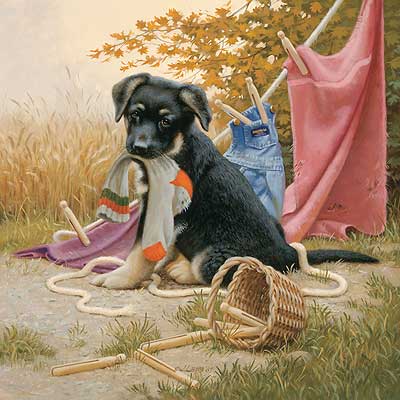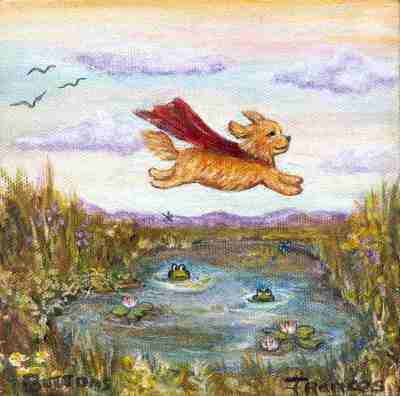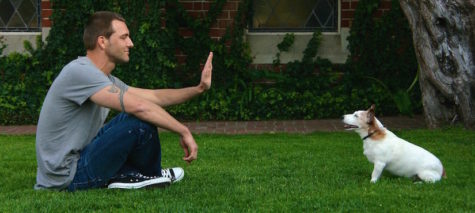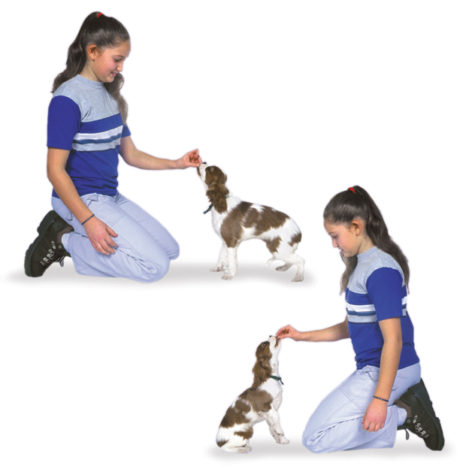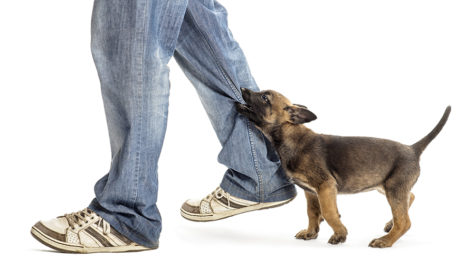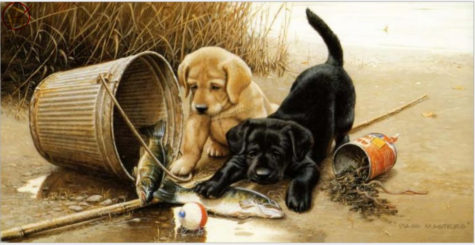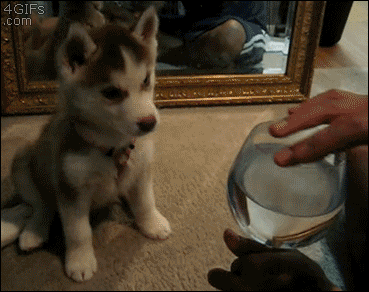Puppy Training
Chewing and Play Biting
Chewing and play biting, how to control it and what do do about it.
STEP 1
Understand the causes – knowing WHY will help you decide WHAT to do.
- If your puppy has an aggressive temperament, chewing and play biting will be a favorite activity.
- Retrieving dogs are very oral, and often do not feel comfortable unless they have something in their mouths.
- Some dog breeds, such as terriers, were bred to catch and kill small game. They have an inbred instinct to “kill” their toys, and whatever they perceive to be “toys.”
- Nervous, anxious puppies sometimes engage in destructive chewing because it helps to relieve anxiety. This is very similar to the nervous habit of chewing on fingernails. When I was in grade school, I regularly chewed on my pencils when taking tests that I didn’t feel prepared for – some puppy chewing is triggered the same way.
- Puppies that are taken from their mother and litter-mates at the age of 5 weeks or younger have missed a critical developmental period. If this is the case, you will have to work longer and harder on the biting problem.
STEP 2
Take appropriate action – do not sit back and expect that your puppy will suddenly “grow out of it.”
If your puppy is bored, teething or full of nervous energy:
- Provide good chew toys, but not too many at a time, and alternate them.
- Wear your puppy out with lots of play and exercise.
- Find a play group with friendly dogs for your puppy to play with.
- Spend some time teaching and reinforcing “Drop It” and “No Bite”
If your puppy gets wired, and goes berserk biting and chewing:
- Avoid wild games and tug-of-war.
- Use correction followed by a short obedience session.
- Be careful that you are not inadvertently praising your puppy for this behavior.
- Insist that your puppy stop when YOU say so.
- Take your puppy for a long walk.
- Find a play group with friendly dogs for your puppy to play with.
- Give your puppy some “time out” in the crate or other secure area.
- You may need to use some stronger corrections, even a good shake by the scruff of the neck. (Do not use this correction with an aggressive puppy, it may escalate the problem.)
If your puppy is regularly picking out specific items to chew on:
- Treat the object (and / or similar ones) with a bitter tasting substance.
- Spend some time teaching and reinforcing “Drop It”
- Devise a booby trap. For example, a cascade of plastic bottles partly filled with pennies (for a noisy landing) and tied together with string might suddenly fall on a puppy busily engaged chewing on the chair leg.
- Use a squirt bottle or shake can and keep it handy.
- Do not leave the puppy alone or unattended with access to things he likes to chew up. This will only teach him that chewing is fun and OK when you aren’t around.
- Do give the puppy plenty of access to things he likes to chew up when you ARE around and PAYING ATTENTION. This will give you plenty of opportunities to teach your puppy what IS and what IS NOT acceptable chewing material.
If your puppy is chewing on you to get attention:
- Try to spend some quality time every day with your puppy.
- Teach your puppy to “fetch,” play ball, or other suitable games.
- Take time to work on some obedience commands with your puppy.
- Find a play group with friendly dogs for your puppy to play with.
- Use distractions, or take your puppy for a long walk.
If your puppy chews on you to stop you from doing something:
- Do not allow this behavior to work for your puppy.
- Be firm and consistent with your corrections.
- Work on building a relationship based on trust and respect.
Important Points:
- Remember, chewing is normal puppy behavior.
- Dogs play bite when they play with each other. It is up to you to teach your puppy that humans do not play the same way as dogs.
- Do not OVER correct chewing behavior if it is caused by anxiety or nervous tension. This will make your puppy even more nervous, and the problem could escalate.
- Do not UNDER correct play biting and mouthing as a form of dominance. Assert yourself now, or you will have bigger problems later.
- Provide plenty of fun alternatives, praise your puppy when he uses them.
- Make sure your puppy gets plenty of physical exercise. A tired puppy is a sleeping puppy. And a sleeping puppy is not chewing or biting.
Written by: Shirley Gibson
Note:
You are welcome to share this post but ONLY IF you give credit and a link back to Teach Your Dog To Behave or shirleytwofeathers.com.
Teaching the Release Command
What it means:
Free puppy. It is now OK to do whatever you want (within reasonable limits).
- Verbal Command: “Perfect!”
- Tone of voice: Happy, excited
- Hand Signal: None
Body Language:
Move forward with your puppy in a happy, thankful, “I’m proud of you!” way.
Enforcing the command:
Clap your hands, pet your puppy, bring your puppy out of position in a positive rewarding manner.
Alternative Command Words:
You can choose whatever word you’d like to use for the release. I like the word “Perfect” because it inspires me to expect perfection from my puppy, and it’s not a word that I use a lot in daily conversation. If you prefer, you can use, “Thank You!” or “Wowsers!” or “Super” or any other word or phrase. Some training methods use “Okay” as a release command. The most important thing is to be consistent with your use of this word.
Do’s and Don’ts:
Be consistent with this command. This is very important, and I cannot stress it enough: Do not allow your puppy to break from any command without this release. This command is a form of praise, and the happy tone of voice is very important, as is the movement forward, and plenty of praise afterwards.
What your puppy learns:
How to please you; how to wait; and that self control is not a ‘forever’ command, and therefore not impossible.
Written by: Shirley Gibson
Note:
You are welcome to share this post but ONLY IF you give credit and a link back to Teach Your Dog To Behave or shirleytwofeathers.com.
Teaching Your Puppy the NO Command
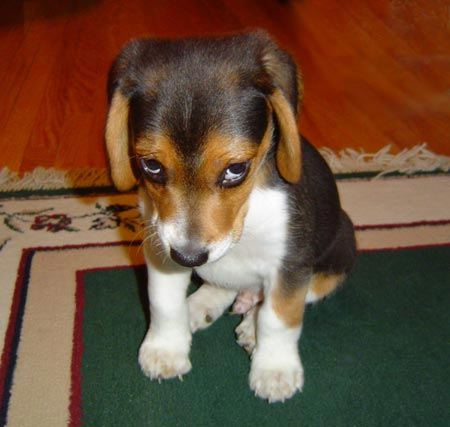 What it means:
What it means:
Stop what you are doing right now. Your behavior is unacceptable.
- Verbal Command: “No!”
- Tone of voice: Firm, demanding, sharp and commanding
- Hand Signal: None
Body Language:
Dominating, confident. Ready to take quick action.
Enforcing the command:
Immediately do what ever it takes to stop the undesired behavior. For example, if your puppy is jumping up on something – pull the puppy off while giving the “No!” command.
The following measures may be used, depending on what it is that your puppy is engaged in:
- Sharper, louder tone of voice.
- More dominating posture.
- Shake can and/or squirt bottle.
- Sharp tug on the collar.
- Scruff shake.
- All four feet off the ground.
Provide an alternative:
As soon as you have deflected or corrected the puppy’s behavior, give them something else to do. Don’t leave the puppy in a vacuum, he may decide to revisit the naughty behavior. Giving the puppy something acceptable to do instead is a great teaching tool.
Here are two examples:
- Chewing on the table leg, use the “No!” command, interrupt the chewing, and then take or call the puppy over to another area of the house and give them a chew toy. This teaches the puppy what IS and what IS NOT acceptable chewing material.
- Being wild and unruly in the house, use the “No!” command, get the puppy’s attention, and then put the puppy in a prolonged “down stay.” This will teach your puppy some self control, and reestablish order in your home.
Follow through:
Give your puppy ample opportunity to make the same mistake over and over again until your puppy chooses not to misbehave. Here are two examples:
- Instead of making the table leg inaccessible to your puppy, allow plenty of access (while you pretend not to notice) so that you can make sure the puppy has “learned” the lesson you are trying to teach. In this case, Chair legs – No. Chew toys – Yes.
- Instead of confining your puppy to a crate when they get “out of control,” insist that the puppy be “in control” of himself for a period of time. In this case, the “down stay.”
Do’s and Don’ts:
Be consistent, be patient, be firm, follow through. Do not give this command if you are not going to enforce it. Use it sparingly but effectively. Always, always, always praise your puppy after the command has been obeyed.
Take action. Do not get into a habit of saying “No! No! No!” over and over. Do not beg your puppy. Do not spend time arguing, explaining, or bargaining. Use the “No!” command and then right away make sure your puppy complies.
Speed is impressive to a puppy. It shows that you have confidence in your abilities as pack leader. Be quick to stop, deflect, interrupt, or otherwise correct the behavior.
Problem solving:
If your puppy runs away and hides after being corrected, the correction was too strong and must be modified. If the bad behavior continues immediately after the correction, the correction was too mild. Your puppy is not taking you seriously, is not respecting your authority, and the correction must be strengthened.
If the unwanted behavior stops immediately after the correction, but continues to occur on a frequent, regular basis, it may be that you are setting up the behavior by:
- Not being consistent.
- Not following through.
- Not establishing your position of leadership.
- Unknowingly encouraging the behavior.
- Forgetting to praise your puppy for good behavior.
Very Young Puppies:
If your puppy is very young, (6 to 8 weeks) your tone of voice should be sharp and firm, loud enough to get your puppy’s attention but not too loud. Physical correction should be surprisingly fast (but mildly firm).
Remember:
Each puppy is different, and with few exceptions, every puppy can be trained. This means that you must out-think, out-last, and sometimes out-smart your puppy.
Written by: Shirley Gibson
Note:
You are welcome to share this post but ONLY IF you give credit and a link back to Teach Your Dog To Behave or shirleytwofeathers.com.
Teaching Your Puppy to Stay
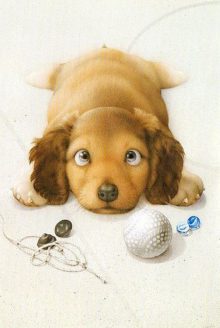 What it means:
What it means:
Freeze in place. Do not move from this spot, or out of this position, until I say you can.
What it doesn’t mean:
Hang around in this general area for a while, and then get up and go do what you want.
- Verbal Command: “Stay”
- Tone of voice: Firm and no nonsense, with an emphasis on the sound “ay”
- Hand Signal: Palm of your hand in front of your puppy’s face. Fingers together.
How to:
Start with your puppy sitting or laying down. Say the command “stay,” use the hand signal, and then move at least one step away, giving your puppy a chance to get up, lay down, or otherwise move out of position. Quickly, put your puppy back into the original position, in the original spot, and repeat the command and hand signal, and then move away again. Do not allow the puppy to move out of position until you give the “release” command. When moving the puppy back into place, use the “No!” command.
Start small:
When working with puppies, start with a stay for a slow count to 5. If that goes well, release your puppy, and then practice on a longer stay. If your puppy moves out of place, start the count all over again. Puppies can usually be expected to stay sitting for as long as 30 seconds, the older the puppy, the longer the stay can be. Puppies can stay in a down position for as long as 5 or even 10 minutes. If they get tired, they can take a nap.
Do’s and Don’ts:
Do not drag out the command “stay” and turn it into “staaaaaay.” Short and quick is how it should be said. The same is true for the hand signal. Show your puppy the palm of your hand as you give the command, and then take your hand away. Do not try to use your hand signal as a way to stop your puppy from moving. Give your puppy every opportunity to move out of position. This will provide you and your puppy with lots of repetition and learning opportunities.
Keep the leash loose, only tighten it when actively putting the puppy back into place. The leash should not be what is holding the puppy in place. The puppy’s own decision to obey you is what should keep him in place.
Don’t hover over your puppy and try to “mind control” him into a stay. You want your puppy to decide to stay put because he wants to please and obey you, not because he sees you hovering. Your relaxed attitude and willingness to quickly put the puppy back into place no matter how often he gets up or runs off reinforces your position of leadership.
Do not give your command as a question: “Stay???” There is no question. Once you’ve said “stay,” the puppy is required to stay.
Scratching and licking is OK. But be aware that it is a signal that the puppy will soon be moving out of place, so be ready to quickly put the puppy back in place.
As much as possible try to correct your puppy as he is in the act of moving, rather than after he has already moved.
Be quick – the speed of your correction is a very effective reinforcement. Move your puppy back into place as quickly as possible. When returning your puppy to the original position, be very particular that it be the original position in the original spot. This is how your puppy will learn that “stay” means freeze in place. It also shows that you were serious about what you said. If your puppy was in a “sit” when you gave the “stay” command, expect the puppy to stay sitting. If the puppy lays down, quickly put the puppy back into a “sit.”
If your puppy is in the “down” position when you gave the “stay” command, don’t let him sit back up, roll over, or creep forward. Quickly move the puppy back into the original position in the original spot, and then hands off and move away. If your puppy falls asleep when in the “down stay” that is perfectly acceptable. But don’t leave the puppy to nap. Wake the puppy up when the “stay” is over.
Don’t let your puppy jump the gun. If you are working on a stay for a count to 15, and the puppy moves at 13, you’ll have to start all over again. Some puppies can tell by your body language that you are about to give the “release” command, and move out of place a split second before you release them. This means that you have a really smart puppy, and its even more important for you to stick to your guns – put that puppy back into place, and start the count all over again.
Never, never, never give up.
Keep working on the stay until you have succeeded. I cannot stress this enough! Your puppy will give in eventually. If it seems like it’s taking forever, or seems impossible, keep count of how many times you had to put your puppy back in place. I once trained a puppy that had to be put back into place more than 132 times. By the time we succeeded at a “count of 20 stay,” we were both exhausted. But that puppy never again tested me on the stay command.
Problem solving:
If your puppy bites at your hands a lot, use the leash to control your puppy’s head while using your left hand to control the rear end. Don’t hover over a biting puppy, this will escalate the problem. Pop the puppy into position quickly and with authority, then stand up straight, or move away. This is not the time to address the biting issue. Avoid and ignore it while teaching stay. Your puppy won’t be able to bite you if he is in a stay and you have moved away.
If your puppy is in a “sit stay” and starts chewing on the leash, pop the leash up with a quick sharp “No!” If this brings the puppy out of a “si stay.” that’s OK. Just put the puppy back into position, and step away. If the puppy can’t seem to leave the leash alone, make the corrections a little more vigorous each time.
If your puppy is in a “down stay” and starts chewing on the leash, give a quick sharp downward pop with the leash and a sharp “No!” If the puppy can’t seem to leave the leash alone, step on the leash close to the collar pinning the puppy to the floor just long enough to make your point. Then move your foot and give the puppy a chance to “be good.”
If your puppy is chewing on your shoe laces or your pant leg, you are too close to the puppy. Repeat the “stay” command and move further away. Expect that the puppy will follow, and use this opportunity to quickly put your puppy back into place and reinforce the “stay” command.
Very Young Puppies:
If your puppy is very young, (6 to 8 weeks) you can sit down (on the floor) with your puppy, and place the puppy in front of you facing sideways. This makes it easier to put the puppy into a sit or a down. As soon as the puppy is placed, let go and move away, staying ready to grab the leash if the puppy tries to bolt.
What your puppy learns:
The most important thing your puppy learns from this command is that you mean what you say when you say it. It teaches your puppy to believe in your authority and your role as leader of the pack. It also teaches physical and mental control. In my opinion, the stay command is the most important command for a puppy to learn.
Stay for a treat:
In my experience treats for the stay command are not effective. If your puppy loves treats, and is strongly motivated by food, you can give a treat AFTER the command has been SUCCESSFULLY executed.
Written by: Shirley Gibson
Note:
You are welcome to share this post but ONLY IF you give credit and a link back to Teach Your Dog To Behave or shirleytwofeathers.com.
Teaching Your Puppy To Sit
 What it means:
What it means:
Sit down, right here, right away.
- Verbal Command: “Sit”
- Tone of voice: Mildly firm, but upward, with an emphasis on the sound “it”
- Hand Signal: Right hand palm up, moving in an upward motion
How to:
Start with your puppy at your left side. Push down gently on your puppy’s rump with your left hand, and at the same time pull UP on the collar or leash with your right hand. The pull up should be a little more forceful than the push down.
Do’s and Don’ts:
Make your puppy sit straight. As soon as you have placed your puppy, let go and stand up. If you lean over your puppy too much, your puppy will tend to lie down. Too much eye contact will encourage your puppy to pop up. Avoid prolonged arguments, give the command “Sit” and then place the puppy immediately into position.
Don’t push down on your puppy’s back, or smash down hard on his hips. Gently curl his butt down and into a sit. If he is resistant to sitting pull up tighter on the leash and sweep is back feet out from under and scoop him into a sit.
Problem solving:
If your puppy bites at your hands a lot, use the leash to control your puppy’s head while using your left hand to push his rump down. Don’t hover over a biting puppy, this will escalate the problem. Pop the puppy into a sitting position quickly and with authority, then stand up straight. This is not the time to address the biting issue. Avoid and ignore it while teaching sit. Your puppy won’t be able to bite you if he is in a sit at your side and you are standing up.
If your puppy starts chewing on your shoe laces, or the leash, or your pant leg, pop up on the leash with a quick sharp “No!” If this brings the puppy out of the sit, that’s OK. Just put the puppy back into position.
Very Young Puppies:
If your puppy is very young, (6 to 8 weeks) you can sit down (on the floor) with your puppy, and place the puppy in front of you facing sideways. This makes it easier to put the puppy into a sit, and discourages leaning on you. As soon as the puppy is placed, let go and move back, staying ready to grab the leash if the puppy tries to bolt.
What your puppy learns:
This command requires your puppy to assume a moderately submissive position. It is usually the simplest command to teach a puppy, and acts as a good introduction to the whole concept of obedience and being trained to learn and obey verbal commands.
Sit for a treat:
Hold the treat in your right hand close to your puppy’s nose. Then, take the treat back over your puppy’s head so that he has to look up and back to keep his eyes on it. Most puppies will spontaneously sit at this point. As soon as he begins to sit, say the word “sit.” The instant that the puppy sits, give the treat. When using food it is important to keep the treat close to the puppy’s nose to discourage jumping up. If the puppy backs up instead of sitting down, put your left hand behind his rear end to stop the backwards motion, and then help him sit.
Do’s and don’ts:
Do not allow the puppy to grab for and get the treat. Because you will be practicing and doing this more than once, use a really small treat, something that smells good and is easy to eat. Don’t worry about teaching the stay command when using a treat for the “sit.” That can come later, after the puppy knows and understands how to sit for a treat. Give the treat to the puppy as soon as he is sitting. Don’t wait for him to get up or move around.
Written by: Shirley Gibson
Note:
You are welcome to share this post but ONLY IF you give credit and a link back to Teach Your Dog To Behave or shirleytwofeathers.com.
Bossy Puppies
How to handle your bossy, dominant, or aggressive puppy.
It is important to develop a good relationship with your puppy based on mutual trust and respect. The following techniques will help to foster this relationship. Different techniques should be used if your dog is older than 6 months.
FIRST:
Establish trust and a desire to please.
- Take long walks with your puppy (on leash).
- Spend 10 minutes every day brushing (grooming) your puppy.
- Attach your puppy’s leash to your waist and make your puppy go with you every where you go when you are home.
- If someone else is regularly feeding your puppy, assume that responsibility yourself.
- All the good things that happen to your puppy should come from you – not forever – but for now.
SECOND:
Establish respect and a willingness to obey using dominance techniques.
- Displace your puppy from a resting place.
- Restrain your puppy for a few minutes.
- Place hands and arms over your puppy’s neck and back, and exert pressure.
- Hold your puppy’s muzzle closed for a few minutes.
- Stare at your puppy until your puppy looks away.
- Pick up your puppy, either partially or completely.
- Push your puppy over on his side and hold him there.
- Roll your puppy over on his back.
Lots of praise when your puppy cooperates. Firm persistence if your puppy resists.
THIRD:
Assert your leadership in a firm and friendly way.
- Reward and/or praise submissive behavior.
- Hold training sessions several times a week.
- Always insist that your puppy obey all the rules.
- Make your puppy earn affection, food, and freedom.
- Firmly correct dominant and/or bossy behavior.
- Wild and unruly behavior is rewarded with a prolonged time-out.
FOURTH:
Learn to recognize and discourage dominant body language:
- Tall stiff stance
- Tail held high
- Flagging, or wagging tail in a taut stiff way.
- Ears up and forward.
- Growling, snarling, etc.
- Direct stare.
- Paws on or over person.
- Standing over someone or something.
FIFTH:
Pack leaders are aloof, they are calm, and they are self confident.
- Attention should be earned.
- Too much attention and coddling will give your puppy an inflated opinion of his place in the family.
- Everything you do with your puppy should radiate confidence and serenity.
- The pack leader is a fair dictator who enforces a well defined set of rules that members know, understand and are expected to live by.
Read and adhere to the Pack Leader’s Bill of Rights. Remember, you are the pack leader, not your puppy!
Written by: Shirley Gibson
Note:
You are welcome to share this post but ONLY IF you give credit and a link back to Teach Your Dog To Behave or shirleytwofeathers.com.
Puppy Training – Guidelines
Know and understand your puppy.
- Your puppy’s temperament will determine what rewards and which corrections will be most effective.
- Take into consideration how your puppy reacts to his senses.
- Don’t forget that your puppy is a DOG, and that certain behaviors are part of his DNA and to be expected.
- Dogs and puppies are motivated by pleasure, pain, fear, and also by their assessment of their place in the family or pack.
- Dogs and puppies have a strong need for leadership. If you do not take the role of leader, your puppy will.
Teach one thing at a time.
- Too many different things at once can be confusing.
- Divide complicated tasks into simple steps.
Take it one small step at a time.
- Make steady improvement easy for your puppy.
- Do not expect too much too soon.
Don’t rush the training.
- You have to walk before you can run.
- Patience and repetition are important words to remember.
Temporarily ease up on everything else when introducing something new.
- The key word here is TEMPORARY.
- Do correct mistakes, but gently and with patience.
- Expect mistakes whenever something new is introduced, or when working with your puppy in a new place.
Plan ahead.
- Know in advance the desired result.
- If your puppy suddenly catches on to what it is you want, this will give you a good opportunity to make quick progress.
If what you are doing isn’t working…
- If what you are doing isn’t working, and you’ve put in the time, the repetition, and the patience – rethink your strategy.
- Trust your intuition.
- Be open to new ideas.
Timing is very important.
- Everything that happens to a puppy happens right now.
- Praise and correction must be handed out during or immediately following the behavior or yhour puppy will not get the message.
When working with your puppy, stay focused.
- Don’t stop in the middle of a session to talk on the phone, smoke a cigarette, or etc.
- Remember, training is a form of communication.
- Removal of attention can be a negative reinforcement.
Positive and negative reinforcements, how to use them:
- The reward for good behavior must outweigh the pleasure gained from the bad behavior.
- The correction must override but not overwhelm the will of the puppy to continue with the bad behavior.
- Use lots of positive reinforcement.
- Be sparing but effective with the negative reinforcements.
If your puppy suddenly “forgets”…
- If your puppy suddenly “forgets” what he has learned, go back to the basics.
- Sometimes a quick refresher is what is needed.
- A relapse midway into training is common and usually means you are about to make a major breakthrough – so don’t get discouraged and quit.
Quit while you are ahead.
- Make progress in each training session
- End each session on a high note.
- Too much pressure or too many repetitions can ruin a training session. Three times in a row is usually suficient.
- If necessary, end the training session on something easy.
A successful outcome depends on these factors:
- Patience and persistence
- Consistency and repetition.
- Whether or not you took the time to follow through.
Written by: Shirley Janner
Note:
You are welcome to share this post but ONLY IF you give credit and a link back to Teach Your Dog To Behave or shirleytwofeathers.com.
Puppy Training – The Basic Principles
A puppy learns through – Consistency and repetition.
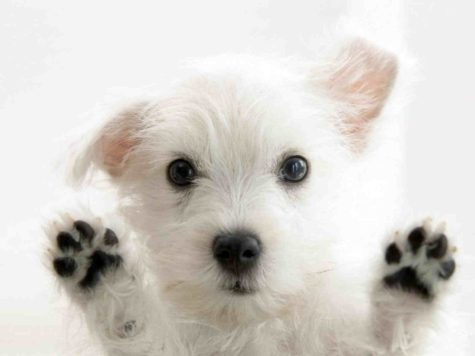 This requires:
This requires:
- Patience
- Persistence
- Confidence
- Follow through
- TIME
You will also need – Knowledge of your puppy’s temperament, an understanding of canine behavior, and a balance of rewards and consequences.
Crimes and Corrections / Praise and Discipline:
- The reward for “good” behavior must outweigh the pleasure gained from the “bad” behavior.
- The correction must override the will of the puppy to continue with the “bad” behavior, without overwhelming the will of the puppy to make decisions.
- The puppy’s confidence in naughtiness must be shaken, and at the same time, the puppy’s confidence in self, and in you, must remain strong.
- An understanding of why your puppy is doing a particular thing can be very helpful, also take into consideration how your puppy reacts to his senses.
- Puppies are motivated by pleasure, pain, fear, and also by their assessment of their place in the family or pack.
- Dogs and puppies have a strong need for leadership. If you cannot take on the role of leader, your puppy will.
Remember:
Everything that happens to a puppy happens right now. Praise and correction must be handed out during or immediately following the behavior or your puppy will not get the message you are trying to get across.
Written by: Shirley Gibson
Note:
You are welcome to share this post but ONLY IF you give credit and a link back to Teach Your Dog To Behave or shirleytwofeathers.com.
